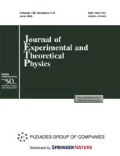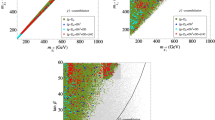Abstract
The possibility of interpretation of the excess in the pp → μ+μ–b\(\bar {b}\) channel observed by the CMS Collaboration (LHC, CERN) at an invariant mass of the muon pair of 28 GeV (\(\sqrt s \) = 8 and 13 TeV) as a signal of one of the Higgs bosons in the minimal supersymmetry has been considered. It has been shown that parametric scenarios with a light pseudoscalar that satisfy the perturbative unitarity conditions in the Higgs sector exist in the regime of large radiative corrections with a light CP-even scalar h corresponding to the observed Higgs boson.


Similar content being viewed by others
Notes
In the existing literature, the “light CP-odd boson” is called the A boson with a mass from 10 to 250 GeV.
The simulation was performed in the approximations characteristic of the PYTHIA generator, i.e., only doubly resonant diagrams are chosen from the total set of the pp → t\(\bar {t}\) diagrams with the subsequent t → b, W+, A or \(\bar {t}\) → \(\bar {b}\), W–, A decay. The total amplitude of, e.g., the gg → \(\bar {t}\)bW+A process with gluons in the initial state is described by 11 diagrams with various resonance thresholds, among which two diagrams are doubly resonant. This leads to theoretical uncertainties of the resulting constraint, which are difficult for estimation.
Any theoretical simulation of the signal was not performed in [10]. Within the MSSM with, e.g., the BP1 set of parameters (see Section 3), the cross section for the signal in the leading order (LO) taking into account the kinematic cutoffs used in [10], is 1.4 × 10–3 fb, and the signal/background ratio for the distribution dσ/d\({{m}_{{{{\mu }^{ + }}{{\mu }^{ - }}}}}\) is 1/35, which is much smaller than the signal/background ratio about 0.1–1 in [10].
The numerical bounds on the cross sections for (i) the e+e– → H1Z process with the further H1 → b\(\bar {b}\) or H1 → τ+τ– decay, (ii) the e+e– → (H2 → H1H1)Z → (b\(\bar {b}\)b\(\bar {b}\))Z process, and (iii) the e+e– → (H2 → H1H1)Z → (τ+τ–τ+τ–)Z, 4) e+e– → H2H1 process with the subsequent decay into the b\(\bar {b}\), τ+τ– states, where H1, H2, and H3 are the neutral Higgs bosons are presented in Appendix B in [13].
The current lower bounds at \(\sqrt s \) = 13 TeV and a luminosity of 137 fb–1 for squark masses are model dependent. Depending on a particular scenario, they are 1190–1630 GeV [55] and can be lower (about 1 TeV) [56]. For this reason and for the analysis of the features of the discussed MSSM regime, we also considered the values MS = 0.6–1 TeV.
See also the remark in Footnote 2 in the Introduction.
At average values of tanβ, τ+ντ was accepted in the discussed analysis as the main mode of the decay of the charge Higgs boson.
In particular, a change in the strong coupling constant gs by 0.1 approximately halves the interaction vertex factor.
REFERENCES
CMS Collab., J. High Energy Phys. 1811, 161 (2018);
J. High Energy Phys. 1711, 010 (2017).
ATLAS Collab., ATLAS-CONF-2019-036. https://cds.cern.ch/record/2684853.
CMS Collab., Phys. Rev. Lett. 123, 131802 (2019).
CMS Collab., Phys. Lett. B 798, 134992 (2019).
M. Carena, S. Heinemeyer, O. Stal, et al., Eur. Phys. J. C 73, 2552 (2013).
A. Djouadi, L. Maiani, A. Polosa, et al., J. High Energy Phys. 1506, 168 (2015).
CMS Collab., arXiv:1911.03781 [hep-ex].
CMS Collab., J. High Energy Phys. 1905, 210 (2019).
CMS Collab., J. High Energy Phys. 1711, 010 (2017).
A. Heister, arXiv: 1610.06536 [hep-ex].
S. Hoche, S. Kuttimalai, S. Schumann, et al., Eur. Phys. J. C 75, 135 (2015).
CompHEP Collab., Nucl. Instrum. Methods Phys. Res., Sect. A 534, 250 (2004);
A. Pukhov, E. Boos, M. Dubinin, et al., arXiv: hep-ph/9908288.
LEP Collab., ALEPH, DELPHI, L3, et al., Eur. Phys. J. C 47, 547 (2006).
M. Carena, S. Heinemeyer, C. E. M. Wagner, et al., Eur. Phys. J. C 26, 601 (2003).
E. Akhmetzyanova, M. Dolgopolov, and M. Dubinin, Phys. Part. Nucl. 37, 677 (2006).
C. Beskidt, W. de Boer, and D. I. Kazakov, Phys. Lett. B 782, 69 (2018).
S. I. Godunov, V. A. Novikov, M. I. Vysotsky, et al., JETP Lett. 109, 358 (2019).
A. Arhrib, R. Benbrik, W. Klemm, et al., arXiv: 1909.12405 [hep-ph].
E. van Beveren and G. Rupp, arXiv:1811.02274 [hep-ph].
G. Lee and C. Wagner, MhEFT Package (2016). http://gabrlee.com/code.
G. Lee and C. E. M. Wagner, Phys. Rev. D 92, 075032 (2015).
J. F. Gunion and H. E. Haber, Phys. Rev. D 67, 075019 (2003).
S. Heinemeyer, W. Hollik, and G. Weiglein, Comput. Phys. Commun. 124, 76 (2000).
H. Bahl and W. Hollik, Eur. Phys. J. C 76, 499 (2016).
H. Bahl and W. Hollik, J. High Energy Phys. 1807, 182 (2018).
M. N. Dubinin and E. Yu. Petrova, Int. J. Mod. Phys. A 33, 1850150 (2018).
ATLAS Collab., Phys. Lett. B 716, 1 (2012).
CMS Collab., Phys. Lett. B 716, 30 (2012).
ATLAS and CMS Collab., J. High Energy Phys. 1608, 045 (2016).
ATLAS and CMS Collab., Phys. Rev. Lett. 114, 191803 (2015).
J. Brandstetter, arXiv:1801.07926v1 [hep-ex].
M. Malberti, Nuovo Cim. C 40, 182 (2017).
S. Coleman and E. Weinberg, Phys. Rev. D 7, 1888 (1973).
H. E. Haber and R. Hempfling, Phys. Rev. D 48, 4280 (1993).
M. Carena, J. Ellis, A. Pilaftsis, et al., Nucl. Phys. B 586, 92 (2000).
S. Y. Choi, M. Drees, and J. S. Lee, Phys. Lett. B 481, 57 (2000).
M. Carena, M. Quiros, and C. E. M. Wagner, Nucl. Phys. B 461, 407 (1996).
M. Carena, J. R. Espinosa, M. Quiros, et al., Phys. Lett. B 355, 209 (1995).
E. Akhmetzyanova, M. Dolgopolov, and M. Dubinin, Phys. Rev. D 71, 075008 (2005).
M. N. Dubinin and E. Yu. Petrova, Yad. Phys. 79, 302 (2016).
M. N. Dubinin and E. Yu. Petrova, Phys. Rev. D 95, 055021 (2017).
A. Djouadi, Phys. Rep. 459, 1 (2008).
H. Haber and G. Kane, Phys. Rep. 117, 75 (1985).
M. N. Dubinin and E. Yu. Petrova, EPJ Web Conf. 158, 02005 (2017).
M. Misiak and M. Steinhauser, Eur. Phys. J. C 77, 201 (2017).
Particle Data Group, Chin. Phys. C 40, 100001 (2016).
B. W. Lee, C. Quigg, and H. B. Thacker, Phys. Rev. D 16, 1519 (1977).
I. F. Ginzburg and I. P. Ivanov, Phys. Rev. D 72, 115010 (2005).
A. G. Akeroyd, A. Arhrib, and E. Naimi, Phys. Lett. B 490, 119 (2000).
M. D. Goodsell and F. Staub, Eur. Phys. J. C 78, 649 (2018);
M. E. Krauss and F. Staub, Phys. Rev. D 98, 015041 (2018).
F. Staub, Phys. Lett. B 789, 2013 (2019).
S. Kanemura and K. Yagyu, Phys. Lett. B 751, 289 (2015).
M. Carena, H. E. Haber, I. Low, et al., Phys. Rev. D 91, 035003 (2015).
D. Asner et al., in 2013 Community Summer Study on the Future of U.S. Particle Physics: Snowmass on the Mississippi (CSS2013), Ed. by N. A. Graf, M. E. Peskin, and J. L. Rosner (Minneapolis, 2013), p. 1.
CMS Collab., J. High Energy Phys. 1910, 244 (2019).
CMS Collab., arXiv:1912.08887 [hep-ex].
G. Lee and C. E. M. Wagner, Phys. Rev. D 92, 075032 (2015).
E. Bagnaschi, F. Brümmer, W. Buchmüller, et al., J. High Energy Phys. 1603, 158 (2016).
H. Bahl, S. Liebler, and T. Stefaniak, Eur. Phys. J. C 79, 279 (2019).
CMS Collab., J. High Energy Phys. 2003, 055 (2020); arXiv: 1911.03781 [hep-ex]; CMS PAS HIG-18-012 (2019).
ATLAS Collab., J. High Energy Phys. 1503, 088 (2015);
Eur. Phys. J. C 73, 2465 (2013).
CMS Collab., J. High Energy Phys. 1511, 018 (2015).
A. Semenov, Nucl. Instrum. Methods Phys. Res., Sect. A 393, 293 (1997);
Comput. Phys. Comm. 115, 124 (1998); arXiv:1005.1909 [hep-ph].
A. L. Kataev and V. T. Kim, Mod. Phys. Lett. A 9, 1309 (1994);
N. Gray, D. Broadhurst, W. Grafe, et al., Z. Phys. C 48, 673 (1990);
S. Gorishny, A. L. Kataev, S. Larin, et al., Mod. Phys. Lett. A 5, 2703 (1990).
A. Djouadi, M. Spira, and P. Zerwas, Phys. Lett. B 264, 440 (1991).
CMS Collab., J. High Energy Phys. 1711, 047 (2017);
ATLAS Collab., Phys. Rev. D 90, 052004 (2014).
J. M. Campbell, R. K. Ellis, and C. Williams, J. High Energy Phys. 1404, 060 (2014);
F. Caola and K. Melnikov, Phys. Rev. D 88, 054024 (2013);
N. Kauer and G. Passarino, J. High Energy Phys. 1208, 116 (2012).
ACKNOWLEDGMENTS
We are grateful to O. Kodolova, A. Nikitenko, H. Bahl, and G. Weiglein for fruitful discussions.
Funding
This work was supported by the Russian Science Foundation (project no. 16-12-10280).
Author information
Authors and Affiliations
Corresponding author
Additional information
Translated by R. Tyapaev
Rights and permissions
About this article
Cite this article
Dubinin, M.N., Fedotova, E.Y. On the Interpretation of the CMS Excess at an Invariant Mass of the Muon Pair of 28 GeV in the Minimal Supersymmetry. J. Exp. Theor. Phys. 131, 917–927 (2020). https://doi.org/10.1134/S1063776120120092
Received:
Revised:
Accepted:
Published:
Issue Date:
DOI: https://doi.org/10.1134/S1063776120120092




